We’ve wanted to explore the ocean coasts of the big islands here every season, but ocean travel means sometimes waiting for good sea conditions so if we have any schedule constraints it’s difficult. We had a perfect window of time so we headed southwest from Sitka to explore new territory. The area just south of town is a dense collection of islands, with nice houses on some of them.
 The houses are turned to face away from the ocean, or to face towards another island for protection. All these places are off the grid – no utilities. Everyone has to provide for themselves.
The houses are turned to face away from the ocean, or to face towards another island for protection. All these places are off the grid – no utilities. Everyone has to provide for themselves.
This has been an unusually cool and wet summer up here, and through the end of July we only had two days with crystal clear blue skies and warm temps in the low 70s. (When you’re acclimated to the 50s, 70 is a little warm.) Locals started referring to it as The Two Days of Summer. As we left Sitka to meander south the forecast showed over a week of beautiful dry weather – yippee!
We took our time, exploring the nooks and crannies, and enjoying the protection of rock reefs and islands. The brilliant skies were glorious, and we aired out deck boxes and let the breeze flow through the boat. In one anchorage a deer and sometimes a fawn hung out in a small grass meadow nearby, munching grass or taking a nap.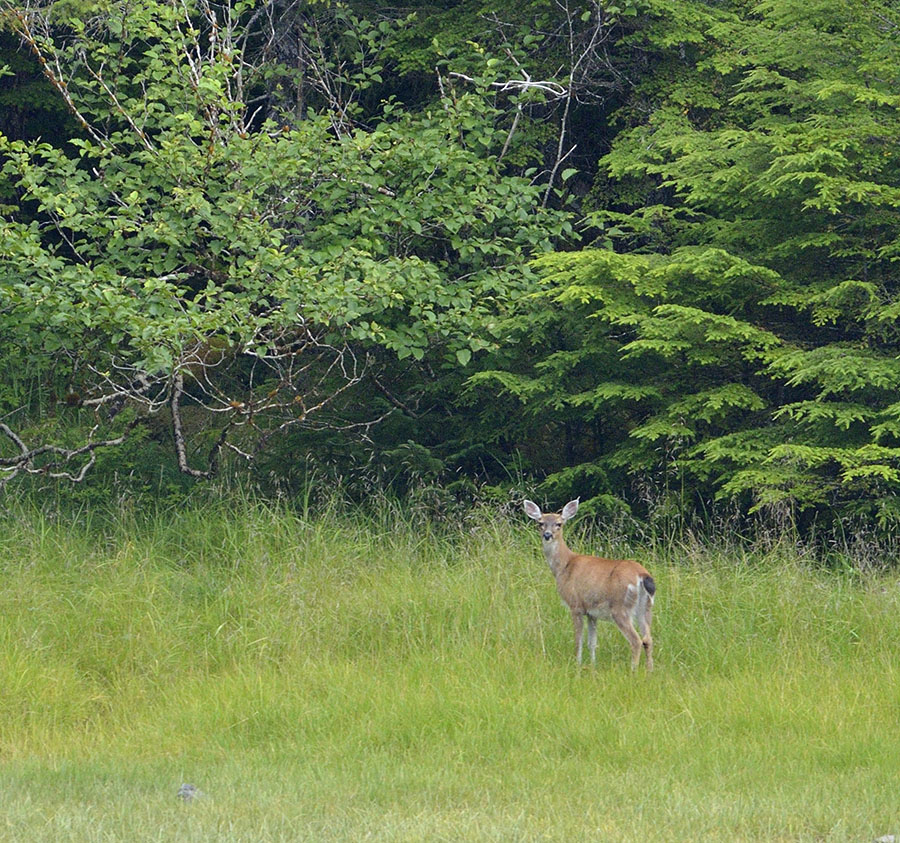
 When the sun shines after such a loooong stretch of wet weather, we did what any self-respecting cruiser would do: work on the boat. Yes, we were enjoying the wild places, but we also took a few hours every day to catch up on some outside chores that can only be done in dry weather. I stripped and re-painted a section of caprail…
When the sun shines after such a loooong stretch of wet weather, we did what any self-respecting cruiser would do: work on the boat. Yes, we were enjoying the wild places, but we also took a few hours every day to catch up on some outside chores that can only be done in dry weather. I stripped and re-painted a section of caprail… …and Jim worked on cleaning rust off some outside lights so they could get some coats of Rustoleum. “Cruising” means fixing your boat in exotic places.
…and Jim worked on cleaning rust off some outside lights so they could get some coats of Rustoleum. “Cruising” means fixing your boat in exotic places. Another bonus with the clear skies was that we got a clear view of Mount Edgecumbe – an extinct volcano.
Another bonus with the clear skies was that we got a clear view of Mount Edgecumbe – an extinct volcano. The mountain is normally visible from Sitka, but it was always hidden in clouds on all our many previous trips. You’ve heard of Plate Tectonics? Well, Mount Edgecumbe sits only 10 miles from the fault line that separates the North American Plate from the Pacific Plate. And that helps to explain why there are several natural hot springs in the area.
The mountain is normally visible from Sitka, but it was always hidden in clouds on all our many previous trips. You’ve heard of Plate Tectonics? Well, Mount Edgecumbe sits only 10 miles from the fault line that separates the North American Plate from the Pacific Plate. And that helps to explain why there are several natural hot springs in the area.
Goddard Hot Springs is run by the Forest Service (since most of southeast Alaska forms the Tongass National Forest), and it has two shelters with a large steel tub and hot and cold water pipes running from the spring and a nearby stream to keep the tubs full. We anchored around the corner in a protected spot, and took the kayaks to the rocky beach to give it a try. The photo above shows the view from the upper shelter, and the photo below shows the lower tub and view.
The photo above shows the view from the upper shelter, and the photo below shows the lower tub and view. The water coming from the spring isn’t hot… it’s SCALDING! I’ve read reports of temps around 109 degrees. We had to run the cold water for about 10 minutes to cool the tub down enough to get in. Jim was a good sport, stirring the water to help circulate the cold.
The water coming from the spring isn’t hot… it’s SCALDING! I’ve read reports of temps around 109 degrees. We had to run the cold water for about 10 minutes to cool the tub down enough to get in. Jim was a good sport, stirring the water to help circulate the cold. After all that sanding and painting, the hot soak sure felt nice. While soaking we studied the graffiti carved into the shelter walls. Fortunately most of the carving and writing was just the names of boats or people. It seemed to be the thing to do, though we like to leave no trace. Some of the artwork in the lower shelter was pretty impressive.
After all that sanding and painting, the hot soak sure felt nice. While soaking we studied the graffiti carved into the shelter walls. Fortunately most of the carving and writing was just the names of boats or people. It seemed to be the thing to do, though we like to leave no trace. Some of the artwork in the lower shelter was pretty impressive. We continued our meander among the Necker Islands, winding our way through narrow cuts and around rocks and reefs. We managed to pick up a good sized rock in our anchor one morning…
We continued our meander among the Necker Islands, winding our way through narrow cuts and around rocks and reefs. We managed to pick up a good sized rock in our anchor one morning… …and were glad that was the extent of the excitement. We spotted some purse seiners working in the channels – silver (also called coho) salmon are the target species around here right now, and we see them jumping all the time.
…and were glad that was the extent of the excitement. We spotted some purse seiners working in the channels – silver (also called coho) salmon are the target species around here right now, and we see them jumping all the time.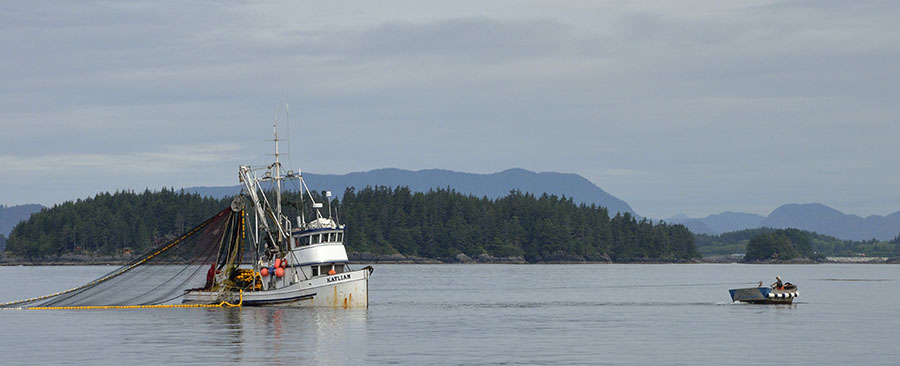 You can see in the photo above, the seiner is hauling his net back in, and the small boat off to the right is his seine skiff. The skiff helps to set the net by drawing it out across the water, and then bringing it around to encircle the fish. When the big boat hauls the net in, the skiff pulls on the opposite side of the boat to help the boat pull the net rather than let the net pull the boat.
You can see in the photo above, the seiner is hauling his net back in, and the small boat off to the right is his seine skiff. The skiff helps to set the net by drawing it out across the water, and then bringing it around to encircle the fish. When the big boat hauls the net in, the skiff pulls on the opposite side of the boat to help the boat pull the net rather than let the net pull the boat.
The seas were building a little and I could feel the swell as I kayaked in between the islands. I had a ball exploring the kelp forests, with tiny kelp crabs and fish hiding underneath, and iridescent turban-topped snails clinging to the broad leaves. What’s amazing about the kelp is that a thick forest does a lot to knock down the ocean swell and smooth the waters. The beaches were more often sandy and there were a lot more shells and fat orange or purple starfish right on the ocean here. Tiny fish fry hid in the crystal clear water, sheltering in placid nooks on the lee side of islands. Beautiful!
The beaches were more often sandy and there were a lot more shells and fat orange or purple starfish right on the ocean here. Tiny fish fry hid in the crystal clear water, sheltering in placid nooks on the lee side of islands. Beautiful! A pair of red-throated loons hung around the anchorage, but always just a little to far away. Sometimes their cries sounded like a baby. I love the perfect pinstripes on the back of their necks. The patterns and details in nature never fail to amaze and delight.
A pair of red-throated loons hung around the anchorage, but always just a little to far away. Sometimes their cries sounded like a baby. I love the perfect pinstripes on the back of their necks. The patterns and details in nature never fail to amaze and delight.

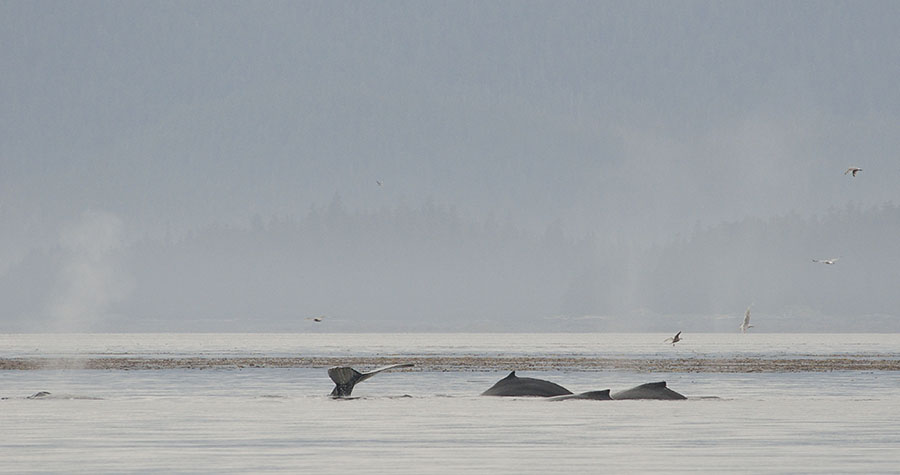 There were at least several whales, and as we approached the area it got very quiet, until the gaping mouths of about 7-8 whales exploded from the water – they were bubble net feeding!
There were at least several whales, and as we approached the area it got very quiet, until the gaping mouths of about 7-8 whales exploded from the water – they were bubble net feeding!
 Humpbacks find a school of small fish, dive underneath them and then one of the whales will blow a “net” of bubbles around the school to pack them in tight. Once the fish are corralled, the whales swim up through the center of the bubble net with mouths agape. It’s quite a sight to witness.
Humpbacks find a school of small fish, dive underneath them and then one of the whales will blow a “net” of bubbles around the school to pack them in tight. Once the fish are corralled, the whales swim up through the center of the bubble net with mouths agape. It’s quite a sight to witness. You can see the distended under-jaw of a whale in the photo above, filled with water and fish. The whale will use his tongue to push the water out, filtering the fish through his baleen – a comb-like structure on the inside of his jaw made of the same type of material as our fingernails (keratin).
You can see the distended under-jaw of a whale in the photo above, filled with water and fish. The whale will use his tongue to push the water out, filtering the fish through his baleen – a comb-like structure on the inside of his jaw made of the same type of material as our fingernails (keratin).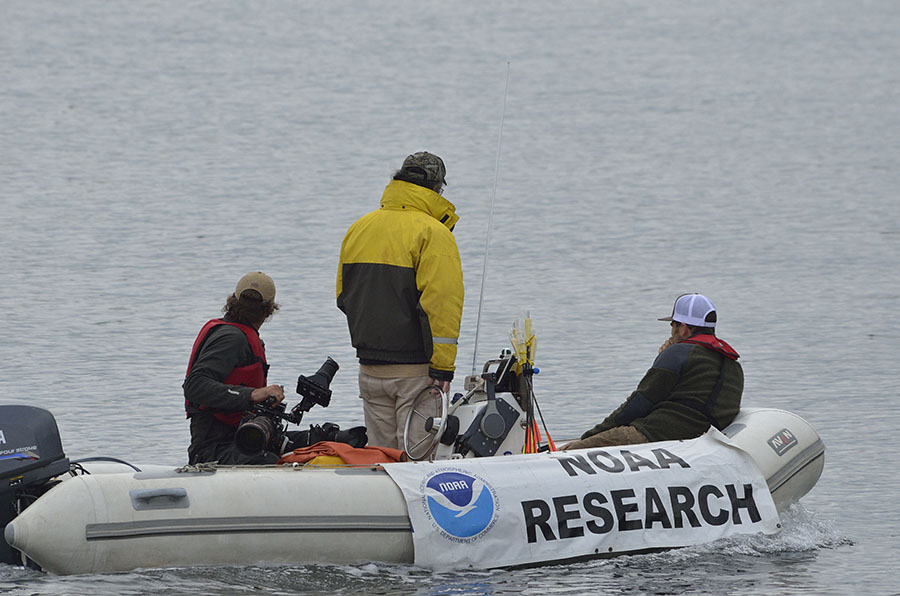 We kept a respectful distance from the whales and the researchers, though the whales were moving in the same direction that we were, so we could watch several cycles of diving and feeding. What a treat!
We kept a respectful distance from the whales and the researchers, though the whales were moving in the same direction that we were, so we could watch several cycles of diving and feeding. What a treat!
 Sitka is a town of about 8000 people – about three times the size of Petersburg. Most summer days it’s visited by a cruise ship, and some of the smaller cruise ships use it as a turnaround point since Sitka has direct air service from Seattle. There are five harbors in town, a thriving fishing fleet of seiners, gillnetters and trollers, and two fish processing plants.
Sitka is a town of about 8000 people – about three times the size of Petersburg. Most summer days it’s visited by a cruise ship, and some of the smaller cruise ships use it as a turnaround point since Sitka has direct air service from Seattle. There are five harbors in town, a thriving fishing fleet of seiners, gillnetters and trollers, and two fish processing plants. The Coast Guard has a helicopter and an ocean-going buoy tender based here, and the channel in front of the harbors also serves as a runway for float planes. This one waited for us to pass so he could take off.
The Coast Guard has a helicopter and an ocean-going buoy tender based here, and the channel in front of the harbors also serves as a runway for float planes. This one waited for us to pass so he could take off. The summer cruising season in southeast Alaska is a special experience, with so much wildlife and fantastic salmon and halibut fishing. People from all over the world come here to tour and fish, and some big yachts – both private and charter – come up for the summer season.
The summer cruising season in southeast Alaska is a special experience, with so much wildlife and fantastic salmon and halibut fishing. People from all over the world come here to tour and fish, and some big yachts – both private and charter – come up for the summer season. I had to laugh because seeing this line of 100’+ yachts reminded me a little of cruising through Fort Lauderdale or Miami, Florida, though the south Florida yacht population is far greater, and the sizes are too. I must confess that I hate all the charter boats and big yachts clogging up our quiet anchorages, and it’s nice when summer is over and the tourist boats have headed south again. A good Alaskan anchorage is one where you’re all alone.
I had to laugh because seeing this line of 100’+ yachts reminded me a little of cruising through Fort Lauderdale or Miami, Florida, though the south Florida yacht population is far greater, and the sizes are too. I must confess that I hate all the charter boats and big yachts clogging up our quiet anchorages, and it’s nice when summer is over and the tourist boats have headed south again. A good Alaskan anchorage is one where you’re all alone. Despite the very rainy weather, we picked up some groceries, ran a few errands, and even did a little shopping. We spotted a poster for “Coffee and Quarks” – an informal talk and Q&A with some visiting young physicists at the Science Center. Over 50 of us jammed the little coffee shop and we could have listened to the panel talk for hours and hours! Afterwards we spent a little time in the wonderful Totem Park run by the National Park Service.
Despite the very rainy weather, we picked up some groceries, ran a few errands, and even did a little shopping. We spotted a poster for “Coffee and Quarks” – an informal talk and Q&A with some visiting young physicists at the Science Center. Over 50 of us jammed the little coffee shop and we could have listened to the panel talk for hours and hours! Afterwards we spent a little time in the wonderful Totem Park run by the National Park Service. The totem poles are all replicas of poles by Tlingit, Haida, and Tsimshian natives from around the region, arranged along a meandering trail through the woods and along the shoreline… sublime.
The totem poles are all replicas of poles by Tlingit, Haida, and Tsimshian natives from around the region, arranged along a meandering trail through the woods and along the shoreline… sublime.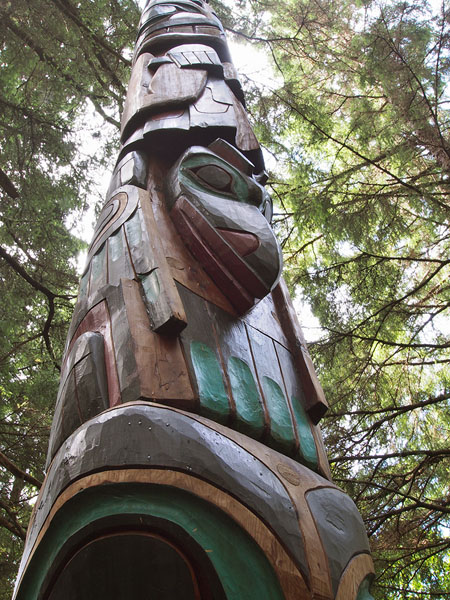
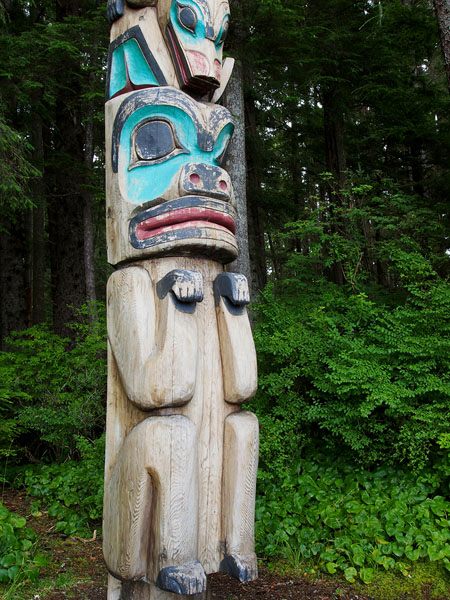 We ran into Petersburg friends who happened to be in the harbor, and it was great to share a glass of wine and catch up about our respective summer adventures. But it was time to move on and for us to explore some new territory to the south, along the ocean coast of Baranof Island.
We ran into Petersburg friends who happened to be in the harbor, and it was great to share a glass of wine and catch up about our respective summer adventures. But it was time to move on and for us to explore some new territory to the south, along the ocean coast of Baranof Island.